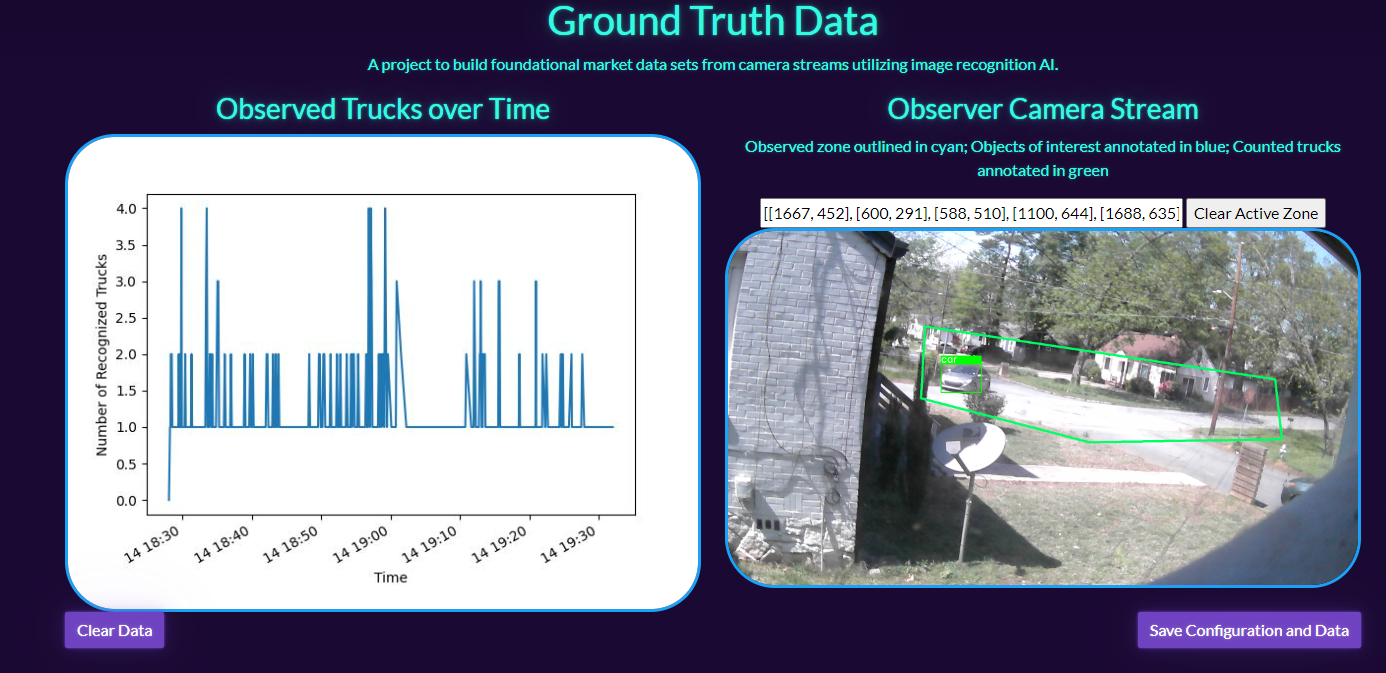A project to build foundational market data sets from camera streams utilizing image recognition AI.
Project Features:
- Live camera stream
- Selection of portion of camera image to use in AI processing
- Object Recogntion AI
- Graph of Object Recognitions over Time
With a provided video stream, let's track and analyze the appearance of object classes over time.
Utilizing Ultralytics YOLOv8, we can classify images for objects the model has been trained on. This can be used to build a dataset of observed objects over time. This can then be plotted to generate observed objects over time graphs.
- Camera Perspective/Placement: cameras are best placed anti-parallel to the movement of objects to be observed; this reduces object blur
- Camera Resolution and Observation Area: a higher resolution camera and/or more of the camera's frame being occupied by the tracked objects will more reliable classifications
This notebook needs a camera stream that will return an JPG image frame with a simple GET request. For a Raspberry Pi, ayufan's camerastreamer is a fantastic choice. The URL for that camera stream should be set in the CAMERA_STREAM variable.
CAMERA_STREAM = "https://localhost:8080/snapshot"import json
import random
from datetime import datetime, timedelta
from io import BytesIO
from time import sleep
import flask
from apscheduler.schedulers.background import BackgroundScheduler
import requests
import numpy as np
import cv2
import matplotlib.pyplot as plt
from ultralytics import YOLOmodel = YOLO("yolov8n.pt")try:
with open("GroundTruth.json", "r") as f:
groundTruthConfig = json.loads(f.read())
groundTruthConfig['DATA'] = [(datetime.fromisoformat(d[0]), d[1]) for d in groundTruthConfig['DATA']]
except FileNotFoundError:
groundTruthConfig = {
"CLASSES_OF_INTEREST": [2, 5, 6, 7],
"COUNT_CLASSES": [2, 7],
"ACTIVE_ZONE": [(0, 0), (1920, 0), (1920, 1080), (0, 1080)],
"DATA": [(datetime.utcnow(), {c: 0 for c in [2, 5, 6, 7]})]
}
CLASSES_OF_INTEREST = groundTruthConfig['CLASSES_OF_INTEREST']
COUNT_CLASSES = groundTruthConfig['COUNT_CLASSES']
ACTIVE_ZONE = groundTruthConfig['ACTIVE_ZONE']
DATA = groundTruthConfig['DATA']def cropToActiveZone(image):
pts = np.int32(ACTIVE_ZONE)
mask = np.zeros(image.shape[:2], np.uint8)
cv2.drawContours(mask, [pts], -1, (255, 255, 255), -1, cv2.LINE_AA)
dst = cv2.bitwise_and(image, image, mask=mask)
return dst
def drawActiveZone(image):
pts = np.int32(ACTIVE_ZONE)
azOverlaidImage = image.copy()
return cv2.polylines(azOverlaidImage, [pts], isClosed=True, color=(100, 255, 0), thickness=5)def collect_images(count=5, rotate=None):
images = []
try:
for i in range(count):
resp = requests.get(CAMERA_STREAM, stream=True).raw
images.append(resp)
images = [np.asarray(bytearray(resp.read()), dtype="uint8") for resp in images]
images = [cv2.imdecode(image, cv2.IMREAD_COLOR) for image in images]
images = [cv2.resize(camImage, (1920, 1080)) for camImage in images]
if rotate:
images = [cv2.rotate(camImage, rotate) for camImage in images]
return images
except Exception as e:
print(f"Failed to collect image: {e}")
return imagesdef demostrateCollectionAndRecognition():
images = collect_images()
aResults = []
for image in images:
results = model.track(image, persist=True, verbose=False)[0]
aResults.append(results)
fig, axes = plt.subplots(1, 5, figsize=(20, 4))
for ax, i in zip(axes, aResults):
ax.imshow(i.plot())
plt.show()ANNOTATED_IMAGE = None
def captureAndAnalyzeImage():
while True:
camImage = collect_images(1)[-1]
results = model(cropToActiveZone(camImage), verbose=False)[0]
annotatedImage = camImage.copy()
recognitions = 0
if len(results.boxes) > 0:
print(f"Detections at {datetime.utcnow()} - {[results.names[int(i)] for i in results.boxes.cls]}")
recognitions = {c: 0 for c in CLASSES_OF_INTEREST}
for box in results.boxes:
if box.cls[0] in CLASSES_OF_INTEREST:
label = results.names[int(box.cls[0])]
print(f"Saw {label}: {box.xyxy}")
x1, y1, x2, y2 = [int(i) for i in box.xyxy[0]]
color = (0, 255, 0) if box.cls[0] in COUNT_CLASSES else (255, 0, 0)
cv2.rectangle(annotatedImage, (x1, y1), (x2, y2), color, 2)
cv2.rectangle(annotatedImage, (x1, y1 - 25), (x2, y1), color, -1)
cv2.putText(annotatedImage, label, (x1, y1 - 5), cv2.FONT_HERSHEY_SIMPLEX, 1, (255, 255, 255), 2)
recognitions[int(box.cls[0])] += 1
DATA.append((datetime.utcnow(), recognitions))
global ANNOTATED_IMAGE
ret, encodedImage = cv2.imencode('.jpg', drawActiveZone(annotatedImage))
ANNOTATED_IMAGE = encodedImage.tobytes()def camStream():
while ANNOTATED_IMAGE is None:
sleep(5)
while True:
yield(b'--frame\r\n'
b'Content-Type: image/jpg\r\n\r\n' + ANNOTATED_IMAGE + b'\r\n')ANALYZER_IMAGE = None
def buildAnalyzer():
while True:
x, y = zip(*DATA)
y = [sum([v for k, v in yi.items() if k in COUNT_CLASSES]) for yi in y]
fig, ax = plt.subplots()
ax.plot(x, y)
plt.xlabel("Time")
plt.ylabel("Number of Recognized Trucks")
fig.autofmt_xdate()
img_bytes = BytesIO()
plt.savefig(img_bytes, format="jpg")
img_bytes.seek(0)
plt.close(fig)
global ANALYZER_IMAGE
ANALYZER_IMAGE = img_bytes.read()def dataStream():
while ANALYZER_IMAGE is None:
sleep(5)
while True:
yield(b'--frame\r\n'
b'Content-Type: image/jpg\r\n\r\n' + ANALYZER_IMAGE + b'\r\n')def generate_oot(*args, **kwargs):
with open('templates/OOT.html', 'r') as f:
ootTemplate = f.read().replace("{active_zone}", json.dumps(ACTIVE_ZONE))
return ootTemplateapp = flask.Flask(__name__)
@app.route('/')
def index():
return flask.Response(generate_oot(), mimetype="text/html")
@app.route('/observer')
def observer():
return flask.Response(camStream(), mimetype='multipart/x-mixed-replace; boundary=frame')
@app.route('/analyzer')
def analyzer():
return flask.Response(dataStream(), mimetype='multipart/x-mixed-replace; boundary=frame')
@app.route('/active_zone', methods=['POST'])
def set_active_zone():
new_active_zone = json.loads(flask.request.form['az'])
if new_active_zone == []:
new_active_zone = [(0, 0), (1920, 0), (1920, 1080), (0, 1080)]
global ACTIVE_ZONE
ACTIVE_ZONE = new_active_zone
return json.dumps(ACTIVE_ZONE)
def saveState(snapshot=False):
global DATA
state = json.dumps({
"CLASSES_OF_INTEREST": CLASSES_OF_INTEREST,
"COUNT_CLASSES": COUNT_CLASSES,
"ACTIVE_ZONE": ACTIVE_ZONE,
"DATA": [(d[0].isoformat(), d[1]) for d in DATA]
})
with open("GroundTruth.json", "w") as f:
f.write(state)
if snapshot:
with open(f"GroundTruth-{datetime.utcnow().isoformat()}.json", "w") as f:
f.write(state)
DATA = [(datetime.utcnow(), {c: 0 for c in CLASSES_OF_INTEREST})]
@app.route('/save', methods=['POST'])
def saveRequest():
saveState(snapshot=True)
return "saved"
@app.route('/clear_data', methods=['POST'])
def clearData():
global DATA
DATA = [(datetime.utcnow(), {c: 0 for c in CLASSES_OF_INTEREST})]
saveState()
return "cleared"
@app.route('/bootstrap.min.css', methods=['GET'])
def getBSCSS():
with open("templates/bootstrap.min.css", "r") as f:
bscss = f.read()
return flask.Response(bscss, mimetype="text/css")
@app.route('/bootstrap.min.js', methods=['GET'])
def getBSJS():
with open("templates/bootstrap.min.js", "r") as f:
bsjs = f.read()
return flask.Response(bsjs, mimetype="application/javascript")
@app.route('/htmx.min.js', methods=['GET'])
def getHTMX():
with open("templates/htmx.min.js", "r") as f:
htmx = f.read()
return flask.Response(htmx, mimetype="application/javascript")
## Periodic tasks for capturing images and analyzing data
scheduler = BackgroundScheduler(daemon=True)
scheduler.add_job(captureAndAnalyzeImage, 'interval', seconds=2)
scheduler.add_job(buildAnalyzer, 'interval', seconds=5)
scheduler.add_job(saveState, 'interval', seconds=300)if __name__ == "__main__":
print(f"Launching Observer Server on 7777")
scheduler.start()
app.run(host="0.0.0.0", port=7777)